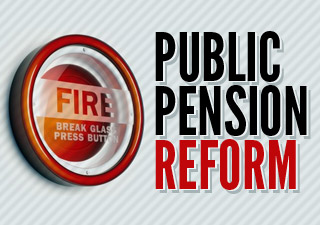Fact Sheet

Principles for Public Pension Reform
Pennsylvania taxpayers fund two statewide pension plans for government employees-the State Employees’ Retirement System (SERS) for state employees and the Public School Employees’ Retirement System (PSERS) for school employees. With taxpayer money, state government pays the entire employer contribution for SERS, and subsidizes approximately half of school districts’ PSERS costs. Local governments also maintain pension plans for police, fire, and municipal employees. There are more than 3,200 retirement plans for local government employees across Pennsylvania, accounting for 25% of all public pension plans in the U.S.
Pennsylvania’s Government Employees’ Pension Crisis
- Higher pension contributions will require additional money from taxpayers.
- Projected taxpayer contributions for PSERS and SERS will increase from $1.7 billion in 2011-12 to more than $6.2 billion in 2016-17—a 263% increase. Contributions will continue to rise at a slower pace in the years that follow.
- The increase breaks down to more than $1,050 in additional tax payments per household/homeowner. Unless government spending is reduced elsewhere, this will require significant increases in state and local property taxes.
- All projections assume a 7.5% annual rate of return on investments. Returns less than that—as occurred during recent recessions—will result in higher taxpayer contributions.
- Pension costs threaten to consume more of the state budget, crowding out other programs.
- The Independent Fiscal Office estimates that pension payments in 2016-17 will represent 11.6% of the state General Fund budget, up from 4.2% in 2011-12.
- Moody’s Investor Services downgraded Pennsylvania’s bond rating in July, noting growing pension contributions will reduce spending flexibility and make it more difficult to balance the state budget.
- Rising pension costs threaten local governments and schools.
- The Pennsylvania Public Employee Retirement Commission reported in 2011 that local government pension plans owe more than $7 billion in unfunded liabilities. Cities across the state, from Scranton to Pittsburgh, are struggling to keep their pension funds solvent and make required payments to retirees.
- Over the past decade, contributions to pension funds have been delayed, enabling state and local governments to hire additional staff. But the pension bill is now coming due. The growing cost of pension contributions is leading to layoffs in schools across Pennsylvania.
Principles for Public Pension Reform
- Benefits should provide government employees a competitive retirement that is affordable for taxpayers.
- Government employees’ pensions should be structured based on taxpayers’ ability to pay. A good benchmark for government benefits is private companies, which typically provide retirement benefits that cost between 4% and 7% of salary per year.
- Retirement costs should be predictable.
- State, school district, and municipal government officials face dramatic pension increases that make it difficult to manage budgets. For instance, PSERS projected contribution rates will rise from 8.65% of payroll in 2011-12 to 28% of payroll in 2019-20. Lawmakers should reform pension systems to offer more stable and predictable retirement costs.
- Retirement contributions should be current.
- Past policy decisions have transferred pension costs onto future generations of taxpayers, making pension costs unsustainable. Taxpayer contributions to employees’ retirement should be made while employees are still working, not long after they are retired.
Five Step Pension Reform Plan
- Establish a single, statewide defined contribution plan for new state and local government workers, school employees, judges, and legislators.
- A defined contribution plan, similar to a 401(k), involves employers (state government, school districts, and local governments, with taxpayer money) matching, up to a set amount, employees’ contributions toward retirement each year.
- Defined contribution plans have no unfunded liability, no long-term taxpayer commitments, and don’t allow politicians to shift costs onto future generations. A defined contribution plan removes politics from pensions while giving teachers and state workers ownership over their retirement.
- Prohibit borrowing schemes to finance benefit plans.
- Pension obligation bonds and other such borrowing is another form of “generational theft”—deferring pension costs onto future generations.
- Adopt statewide funding reforms consistent with new government accounting rules.
- Achieve an annual employer cost of 4% to 7% of payroll using standardized rules, utilizing current market value of pension assets, and paying off unfunded liabilities while employees are still working.
- Prohibit benefit increases that would result in a funded ratio below 90%; that is, a government agency must keep on hand at least 90% of the pension benefits it owes.
- Modify unearned pension benefits to the extent legally permitted.
- Employee and retiree benefits already earned are legally protected, but benefit formulas for current employees going forward may be modified to an affordable and sustainable plan.
- This could include reducing the pension benefit formula, redefining what earnings count towards pension benefits, increasing the normal retirement age, curtailing early retirement subsidies and Deferred Retirement Option Programs, eliminating cost of living adjustments, and increasing employee contributions.
- Other Post-employment Benefits—such as health care benefits for retirees—should also be modified to reduce the unfunded liabilities taxpayers owe.
- Provide funding reforms to fully fund pension plans without increasing taxes or borrowing only after prior steps are achieved.
Omitting any steps falls short of comprehensive pension reform to protect current and future taxpayers.
# # #
For more information on Pensions, visit www.CommonwealthFoundation.org